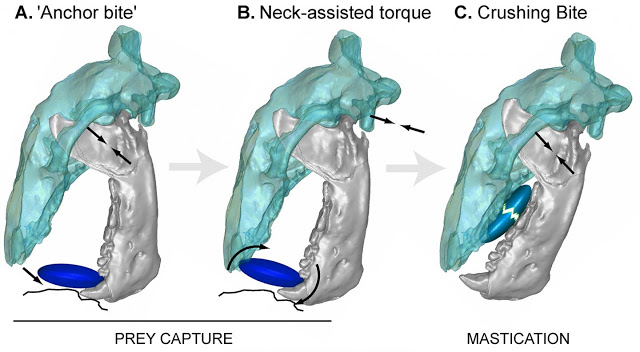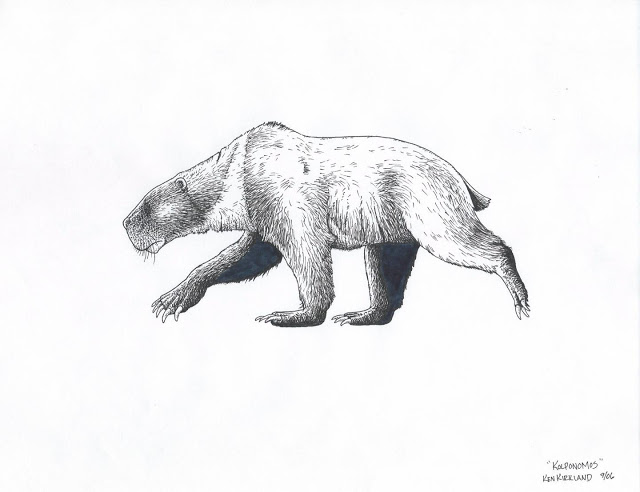

| Online: | |
| Visits: | |
| Stories: |

| Story Views | |
| Now: | |
| Last Hour: | |
| Last 24 Hours: | |
| Total: | |
Extinct Otter-Like ‘Marine Bear’ Might Have Had a Bite Like a Saber-Toothed Cat
New research suggests that the feeding strategy of Kolponomos, an enigmatic shell-crushing marine predator that lived about 20 million years ago, was strangely similar to a very different kind of carnivore: the saber-toothed cat Smilodon.
This image shows lower jaw stress models of Kolponomos newportensis (left) versus Smilodon fatalis during an anchor bite.

Credit: @ AMNH/J. Tseng, C. Grohé, J. Flynn
“When Kolponomos was first described in the 1960s, it was thought to be a raccoon relative,” said Camille Grohé, a National Science Foundation and Frick Postdoctoral Fellow in the American Museum of Natural History’s Division of Paleontology and a co-author on the new paper. “But later research on the skull base led some to think it might be a seal or a bear relative instead, and studies of its teeth show that they are very similar in both shape and wear to the teeth in sea otters.”
Sea otters pry their prey–hard-shelled marine invertebrates like clams and mussels–off of surfaces using their hands and rock tools, then crush the shells with their teeth or against their chests, again using tools. By studying Kolponomos fossil material from the National Museum of Natural History in Washington, D.C., and comparative specimens from the American Museum of Natural History, the research team originally set out to test if the extinct predator used otter-like shell-crushing to eat. But the scope of the research expanded after Grohé’s collaborator Z. Jack Tseng noticed something curious in parallel to work he was conducting on the saber-toothed cat Smilodon.
The new work suggests that that Kolponomos might have pried prey off of rocks with its lower jaw, swung its skull forward to dislodge it, and then crunched it with its chewing teeth.

Credit: @ AMNH/J. Tseng, C. Grohé, J. Flynn
At the Museum’s Microscopy and Imaging Facility, the researchers used computed tomography (CT) to scan the skulls of Kolponomos and six other carnivores: Smilodon, grey wolf, sea otter, river otter, brown bear, and leopard. They then used computerized methods to build sophisticated biomechanical models to look at how efficiently the animals could perform various bites, including the jaw-anchored killing shear-bite that is characteristic of saber-tooth cats.
They found that the jaw mechanics of Kolponomos and Smilodon are more similar to each other than to any of the other animals in the study, pointing to a unique feeding strategy in addition to the previous idea that Kolponomos might have crushed its prey like sea otters do today. Taken together, the researchers suggest that Kolponomos might have pried prey off of rocks with its lower jaw, swung its skull forward to dislodge it, and then crunched it with its chewing teeth.
“Our biomechanical data show that the chewing bites of sea otters and Kolponomos are not very similar,” Tseng said. “They probably still have an overlapping diet based on tooth wear, but their evolutionary solutions for getting to those hard-shelled animals are dramatically different.”
The researchers stress that this finding does not imply shared ancestry between Kolponomosand Smilodon, but rather an intriguing case of convergence–the independent evolution of similar traits.
“This innovative study, showing unexpected feeding similarities between such wildly distinct carnivores, could only happen by applying new technologies to understand specimens from some of the world’s greatest archives of ancient life,” said John J. Flynn, a curator in the Museum’s Division of Paleontology and Dean of the Richard Gilder Graduate School, also an author on this paper.
This work was funded by the U.S. National Science Foundation grant # DEB-1257572 and the American Museum of Natural History’s Frick Postdoctoral Fellowships.
The authors have dedicated this study to the memory of Museum artist Chester Tarka, who illustrated Kolponomos newportensis. Tarka, a decorated Army veteran of the Normandy Invasion and Battle of the Bulge in WWII, passed away recently at the age of 96 and was buried with military honors in Saratoga, New York.
Contacts and sources:
The American Museum of Natural History
Source: http://www.ineffableisland.com/2016/03/extinct-otter-like-marine-bear-might.html



